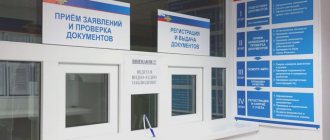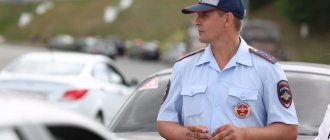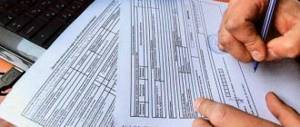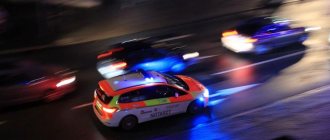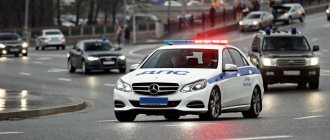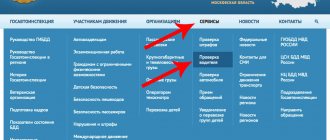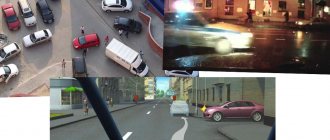A car is about speed, but some drivers have a desire to drive faster than others, and they use special signals. But the siren, flashing lights and other special signs are intended for services that rush to help people in trouble. And therefore, their unauthorized use is prohibited by the Code of Administrative Offenses, as well as refusal to let a car with a special signal pass.
In this article:
What is considered a special signal?
Cars of emergency or simply special services are distinguished by light, color icons, and sound, which they do not have
other vehicles:
- flashing lights in blue and other possible colors;
- siren or “quack”;
- light-signal beams (flashing lights);
- flash lights;
- colored and reflective stripes;
- strobes;
- loudspeakers.
They are installed so that other motorists can see special vehicles and provide them with the opportunity to drive faster.
GOST for special signals
GOST for special signals used in Russia is numbered R 50574-2002. It regulates the appearance of the lights of emergency vehicles (police, fire departments, ambulances, military inspection, FSB, Investigative Committee). The standard also dictates the types of permitted sound signals, as well as color schemes applied to special vehicles.
GOST does not affect the use of yellow flashing lights installed on trucks or equipment for road construction and repair work. This is another confirmation that they are not special signals.
Who has the right to drive with a flashing light?
The following cars have the right to drive with their flashing lights on:
- ambulance, if they are rushing to respond to a call or transporting a patient to the hospital;
- police when going on a mission;
- fire service when they go to extinguish;
- military police;
- Ministry of Emergency Situations, if the vehicle is traveling to carry out rescue operations;
- FSO, FSB, SK, for whatever purposes they are used;
- National Guard.
Types of cars with special signals
In Russia, State Duma deputies and members of the Federation Council, ministers, and governors can also drive with flashing lights. The list is determined by Presidential Decree N635 of May 19, 2012.
Certificate for special signals
For each driver working in the police or other emergency services, a special type of certificate is issued - for special signals. The document is issued after completing training courses at an educational institution that has a special license.
Drivers of special services, among other things, must master the skills of extreme driving, the use of radio communications, and special signals. After a full-time or part-time course, they take an exam, and only then receive a document for permission to work. The certificate is valid for a maximum of 5 years, after which retraining is required. All this is carried out in accordance with Decree of the Government of the Russian Federation No. 876 of 2007.
As for permits for the use of special equipment for cars, their issuance is regulated by Order of the Ministry of Internal Affairs No. 167 of 2007. It states that:
- permission to install and use white beacons is given to Russian Post, collectors and vehicles transporting valuable cargo;
- the possibility of using yellow and orange light devices is available for road equipment and vehicles with dangerous, oversized cargo, buses transporting children in an organized manner;
- permission to use blue and red beacons, as well as the devices themselves, are issued only by the Ministry of Internal Affairs of the Russian Federation.
That is, if there are grounds, you can install a white or yellow light signal on the car. But for red or blue you need a special permit.
Did you miss the ambulance? Fine from 3000 rubles or imprisonment
On August 6, 2021, laws on changes to the Administrative and Criminal Codes will come into force, which will tighten liability for “Obstruction of medical care.”⠀
Let's understand these changes.
If the driver did not give way to the ambulance and this did not entail any consequences (that is, the patient did not die or did not get worse), then he will face a fine of 3,000 to 5,000 rubles or deprivation of his license for a period of 3 months to 1 year. Previously, the punishment was milder: a fine of 500 rubles. or deprivation of rights from 1 to 3 months.
The same applies to any transport of special services (EMERCOM, firefighters).
But don’t forget - special service vehicles must have blue flashing lights and an audible signal turned on at the same time. If only beacons are turned on, then the punishment does not apply.
Sources: Code of Administrative Offenses of the Russian Federation Article 12.17, Federal Law dated July 26, 2019 No. 229-FZ “On amendments to the Code of the Russian Federation on Administrative Offenses in terms of ensuring the rights of citizens to medical care.”
If the driver does not give way to the ambulance and this results in serious harm to the patient’s health, the driver will be punished with a fine of up to 80,000 rubles or in the amount of salary for up to 6 months - restriction of freedom for up to 3 years - forced labor for up to 2 years - arrest for up to 6 months - imprisonment for up to 2 years.
If the driver did not give way to the ambulance and as a result the patient died, then the driver will face - restriction of freedom for up to 4 years - forced labor for up to 4 years - imprisonment for up to 4 years
Source: Federal Law dated July 26, 2019 No. 206-FZ “On amendments to the Criminal Code of the Russian Federation and Article 151 of the Criminal Procedure Code of the Russian Federation regarding the protection of the life and health of patients and medical workers”
How in practice they will prove that it is the driver who is to blame for the deterioration of the patient’s condition and choose the punishment, it is still unclear. Judicial practice will show in the near future.
In the meantime, let us remind you how to correctly give way to ambulances (firefighters, Ministry of Emergency Situations):
1. A special services vehicle must have flashing blue lights and an audible signal turned on simultaneously in clause 3.2 of the Russian Traffic Regulations.
2. The 2021 traffic regulations require not to pass, but to give way for unhindered passage, clause 3.2 of the Russian Federation Traffic Regulations. Give way (do not create interference) has a specific definition in clause 1.2 of the traffic rules. That is, when an ambulance approaches with its beacons and signal turned on, the driver is obliged: - not to start or resume movement - not to make maneuvers - not to continue driving if this forces the ambulance to change direction or speed.
If you strictly follow the traffic rules, then the driver is not required to press against the neighboring car in order to give way to the ambulance. Of course, from a human point of view, you need to do everything to let the ambulance pass, but at the same time be attentive to what you do and violate, so as not to be guilty later.
Good luck on the roads!
The procedure for using special light and sound signals
The procedure for using special light and sound signals on public roads is regulated by clause 3 of the Traffic Regulations of the Russian Federation and is as follows:
those who have the right to a blue car beacon, if absolutely necessary, can ignore traffic lights and demand to give way to them in violation of the rules;- the same is permitted for vehicles accompanied by cars with blue or red lights;
- Special vehicles can violate traffic rules only after making sure that they are given way;
- the light signal on such a machine must be supplemented by the inclusion of sound;
- When a special vehicle approaches, other vehicles must move to the side or slow down to let it pass;
- It is prohibited to overtake emergency vehicles driving with working signals;
- if it is stationary, but the beacon and siren are on, an ordinary car should reduce speed as it approaches;
- yellow and orange beacons do not give priority in travel, but vehicles with them can, if necessary, ignore markings and road signs, except for 2.2, 2.4 - 2.6, 3.11 - 3.14, 3.17.2, 3.20;
- they may also not comply with the rules of paragraphs 9.4-9.8 and 16.1 of the traffic rules, if this does not threaten traffic safety;
- white beacons on Russian Post vehicles, collector vehicles carrying valuable cargo can be turned on only if there is a threat of attack on them;
- The cars listed in the previous paragraph do not have access rights.
More on AutoLex.Net:
An unexpected fine for many people for low speed: what punishment can there be for “turtles” on the road?
Watch this video about traffic rules when using special signals:
Does the driver of a car with special signals violate traffic rules?
The rules for using flashing beacons are described in Chapter 3 of the rules of the road. Let's turn to paragraph 3.1:
3.1. Drivers of vehicles with a blue flashing light turned on, when performing an urgent official task, may deviate from the requirements of sections 6 (except for traffic controller signals) and 8 - 18 of these Rules, appendices 1 and 2 to these Rules, provided that traffic safety is ensured.
To gain an advantage over other road users, drivers of such vehicles must turn on a blue flashing light and a special sound signal. They can take advantage of priority only by making sure that they are given way.
Basic rules that every driver should know:
- If a car has only a blue beacon turned on (or blue and red beacons) and the sound signal is not turned on, then such a car may deviate from the requirements of some points of the rules (they will be discussed below). Other vehicles must not give way to such a vehicle.
- If a car’s blue beacon (or blue and red beacons) and sound signal are turned on at the same time, then other vehicles must give way to such a car.
However, within the framework of this article, we are primarily interested not in priority over other vehicles, but in points of the rules that can be ignored.
It is important to understand that a car with a blue light on has the right to deviate from the requirements of certain clauses of the rules. That is, the driver can ignore these points. However, this is not a violation and the driver cannot be held administratively liable .
You also need to pay attention to the phrase “subject to ensuring traffic safety” from paragraph 3.1. From it we can conclude that if a car with special signals that violates the requirements of the rules gets into an accident (it cannot ensure traffic safety), then one of the culprits of the accident will be the driver of this car.
Blue flashing beacon
A blue flashing light may indicate that the vehicle belongs to:
- police or other law enforcement agency;
- Ambulance;
- fire service.
If the driver of a special vehicle needs to pass first, he must also turn on the sound signal. In the absence of a siren or quack, ordinary cars are not required to give way. If the driver does not allow the car to pass with a special signal, he faces Part 1 of Article 12.17 of the Administrative Code, that is, a warning or a fine of 500 rubles.
How to properly let an ambulance pass?
Tougher penalties for ignoring emergency signals oblige drivers to be doubly careful on the road. Often, violation of the rules in relation to a car following the road with a flashing light and an audible signal is not due to malicious intent, but to the psychological reaction of motorists who are lost in such situations.
On any route, in addition to the rules for allowing an ambulance to pass, there are other traffic rules that must also be observed. Sometimes a driver who lets an ambulance pass is punished for violating other traffic regulations.
The algorithm of actions when an ambulance approaches is as follows:
- reduce speed or stop, remaining in this position until the special vehicle passes by;
- if it is possible to clear the roadway, it is necessary to do so;
- if the car is stationary when the ambulance approaches, do not start driving until it has passed;
- If in order for a special vehicle to pass, it is necessary to change lanes or make another maneuver, this must be done without violating traffic rules and without interfering with other vehicles.
Such information will help the driver avoid panic and act in accordance with the law.
It would also be useful to indicate in which cases vehicles equipped with special signals enjoy the right of way (this is enshrined in paragraph 3.1 of the traffic rules):
- the car must activate the blue flashing light;
- The car's horn must be turned on.
If at least one of the requirements is not met, other motorists are not required to give way. Signaling with the horn also does not give the special vehicle the right of way.
Lunar-white flashing beacon
A white-lunar flashing light means that the car is carrying material assets and has been attacked. This signal is needed to attract the attention of the police and is a request for help. If the car is simply moving in the general flow, there is no threat of attack, the beacon is not used. And he has no advantages in travel. Like everyone else, its driver is obliged to comply with traffic rules.
Why do the police have red and blue flashing lights?
The police may have red and blue flashing lights because this combination attracts
more attention than a single beacon color.
But such cars do not have any additional privileges, other than those established in clause 3 of the traffic rules. They give way if the light accompaniment is complemented by sound. In this case, ordinary cars must allow special vehicles to turn around, turn, drive in reverse, etc.
Do I need a permit for a yellow flashing light?
There is no special need to obtain permission for a yellow flashing light. If a driver in his car has to perform work that requires such a beacon, the device is simply purchased at the store and installed.
There is no point in using it just like that. A yellow flashing light does not provide any special advantages on the road. Only vehicles involved in road repairs can ignore the markings, and when clearing roads from snow, they can perform maneuvers where others cannot. But here we are talking about special equipment that has a corresponding appearance. And installing a yellow flashing light on a regular car will not protect its driver from punishment for violating traffic rules.
Possibility of deviation from the rules for Ambulance
Ambulances belong to the category of vehicles whose drivers have the right to use special signals that give them an advantage when driving on the road.
This possibility is provided for in Section 3 of the current Traffic Rules. At the same time, however, in order to gain advantage on the road, the ambulance driver must turn on his existing blue flashing light and an audible signal, which is often referred to in common parlance as a siren. In this case, the driver has the right not to comply with traffic rules. However, even in such a situation, there are a number of restrictions for the ambulance driver. Firstly, of course, the use of special signals and deviations from current traffic rules should be due to urgent need, for example, when a car is in a hurry to respond to a call to a seriously ill patient. Secondly, the driver can deviate from the rules only if he has first made sure that other road users are giving way to him and he is not creating an emergency situation. Finally, some requirements of the rules, for example, traffic controller signals, are mandatory to comply with even for an ambulance with a flashing light and sound signal turned on.
What is the penalty for violation?
Attaching a special signal to an ordinary car misleads other people, provokes chaos on the road, and creates an increased threat. Therefore, the act is punishable by monetary payment or deprivation of rights.
For unauthorized installation and use on a car
There is a ban on installing special signals on a regular vehicle in the Code of Administrative Offences. Sanctions for this are reflected in section 12.4, more precisely in its 2nd and 3rd parts:
if a motorist has installed signs of operational organizations on his car or those that have the right to be only on a taxi, a disabled person’s vehicle, he will have to pay 5,000 rubles for this;- the same violation, but committed by an official, is punishable by a fine of 20,000 rubles;
- a similar offense in which a legal entity is involved will result in the payment to them of 500,000 rubles.
And in each of the above cases, inappropriate distinctive items will be confiscated. It is prohibited to make an ordinary car look like a police car, a cash-in-transit car, a fire truck, or an ambulance. But section 12.4 of the Code of Administrative Offenses concerns only cases of installation of special signals. That is, it can also be applied when the motorist has not turned on prohibited devices.
More on AutoLex.Net:
Cancellation of the statute of limitations for administrative fines
Driving in vehicles with illegally installed and operating special signals is punishable in accordance with Section 12.5 of the Code:
- a motorist driving a vehicle with the designation “disabled” or the external elements of a passenger taxi will pay 5,000 rubles to the budget;
- for driving a car, the body of which is decorated with color stripes like a special service vehicle, you will have to do without a driving license for up to 1.5 years;
- Driving a car with light and sound elements turned on, corresponding to those found on emergency services and law enforcement vehicles, will result in the driver being left without a driver's license.
Applying colored elements to the body, simulating vehicles of special organizations, and driving a painted car will lead to the requirement to submit a license for the same period of time. In all of the above cases, special signals will be confiscated.
For information on fines when installing special signals on vehicles, watch this video:
For not allowing a car with special signals to pass
According to the law, police, traffic police, ambulance, fire service vehicles, as well as those belonging to government agencies, should be allowed through if they are driving with their special lights on. But not all drivers of personal vehicles do this. Such a violation can lead to tragedy and is therefore punishable. There is section 12.17 (part 2) about it:
Failure to provide priority in movement to a vehicle that has special color schemes, inscriptions and designations applied to the outer surfaces, with a blue flashing light and a special sound signal simultaneously turned on, entails a fine of five hundred rubles and deprivation of the right to drive the vehicle for a period of one to three months.
We are talking about ambulances, police vehicles, traffic police, and fire departments. These sanctions have been determined at the moment. But a draft amendment has been submitted to the State Duma, according to which it is proposed to fine drivers who do not allow special transport to pass by 30,000 rubles.
To learn about increasing liability for not allowing cars with special signals to pass, watch this video:
Penalty for strobe lights
The fine for stroboscopes installed on a car is imposed under Part 1 of Article 12.4 of the Code of Administrative Offenses and amounts to 3,000 rubles. After the vehicle is seized by an inspector, the devices are confiscated. The color and operating mode of the luminous devices do not matter. And the fine for white strobes will be the same as for red or blue ones. After all, with them, transport ceases to comply with the “Basic provisions for the admission of vehicles to operation...”.
The same fine applies to strobe lights in the cabin installed under the windshield or in another place. In these cases, unnecessary parts also make the car non-compliant with the regulations. True, punishment will be avoided with a greater degree of probability. After all, traffic police officers do not have the right to inspect a car without a good reason. Otherwise, it is unlikely that it will be possible to detect the lighting devices; after seeing a policeman, the driver can quickly turn them off.
And yet, you shouldn’t risk installing unnecessary parts even in the interior. When turned on, they are distracting and make operating the machine more tedious, which reduces safety.
Therefore, sanctions for similar things exist in other countries. For example, the fine for strobe lights in Kazakhstan is 15 times the minimum wage. You cannot use unnecessary lighting devices on your car or near your neighbors. The fine for strobe lights in Ukraine is several thousand hryvnia.
Fine for yellow flashing lights
A driver may be fined for having a yellow flashing light if he is required to use it by law, but there is no light device on the car, or it is not turned on. It is imposed if:
- Transport carries dangerous, large cargo or accompanies it, participates in the repair or cleaning of the road, and the evacuation of other vehicles. In these cases, the payment will be 500 rubles. under Article 12.20 of the Code of Administrative Offences.
- Transport is used for organized transportation of children. If there is no flashing light on the bus, the penalty is imposed under Part 4 of Article 12.23 of the Code, this is a fine of 3,000 rubles.
There is no special sanction in the law for the use of a yellow light signal. But if the car does not perform any of the types of work for which the device is required, but it is still there, they will be punished at least under Part 1 of Article 12.4 for 3000 rubles. Responsibility for a yellow flashing light, if the driver is driving such a car, is imposed under Part 3 of Article 12.5. That is, he will be deprived of his rights for 6-12 months.
Fine for “quack”
The fine for a police “quack” is imposed under Part 2 of Article 12.4 of the Code of Administrative Offenses:
Installation on a vehicle without the appropriate permission of devices for giving special light or sound signals (with the exception of security alarms) ... entails the imposition of an administrative fine on citizens in the amount of five thousand rubles with confiscation of the subject of the administrative offense ...
It is only due to the fact that the device is on the machine, but is not used. Traffic police officers conduct raids to identify such cars, and it is very easy to fall under this article. If the driver turned on the “quack”, he will be punished under Part 4 of Article 12.5 of the Administrative Code:
Driving a vehicle on which devices for sending special light or sound signals (with the exception of security alarms) are installed without the appropriate permit shall entail deprivation of the right to drive vehicles for a period of one to one and a half years with confiscation of these devices.
Cars can be used as mobile advertising, in which case a loudspeaker is sometimes required. But permission for SGU should be obtained from the traffic police. Installing a device is a change to the design of the car and is formalized accordingly. The registration document must contain a record of its availability and a description of the type of device.
More on AutoLex.Net:
What will be the punishment for exceeding the speed limit by 10 kilometers per hour in 2021, the dispute over unpunished speed limits
Fine for flashing beacon
The fine for an illegally installed flashing light is:
- 3000 rub. and is imposed under Part 1 of Part 12.4 if the device is yellow;
- 5000 rub. and is issued under Part 3 of the same article, if it is the same as for the police, ambulance or Ministry of Emergency Situations.
That is, the fine for a blue or red-blue flashing light is 5,000 rubles, and for a yellow or orange one – 3,000 rubles.
If a driver turns on illegally installed signal lights on the road, it will cost him even more:
The use of devices for producing special light or sound signals (with the exception of security alarms) installed without the appropriate permission while driving a vehicle entails deprivation of the right to drive vehicles for a period of one and a half to two years with confiscation of these devices.
Fine for beeping in the city
A fine for an unreasonable sound signal in the city can be issued under Article 12.20 of the Code of Administrative Offences, it will amount to 500 rubles. Drivers manage to get away with a written warning. Similarly, a fine is imposed for honking in a residential area, where there is no need to sound the car horn at all, and such a driver’s action brings a lot of inconvenience to many people at once.
The article of the Code of Administrative Offenses does not mean that honking within the city is completely prohibited. Sound is used to warn other road users of danger. If it’s not there, don’t needlessly scare passers-by.
There is also a fine for a non-functioning sound signal - 500 rubles. according to Part 1 of Art. 12.5 Code of Administrative Offences. Here, too, you can get by with a warning from a traffic police officer.
A law establishing a fine for failing to allow an emergency vehicle to pass.
The fine for failure to comply with the requirement to give way to an ambulance is established by Part 3 of Article 12.17.
2. Failure to provide priority in traffic to a vehicle that has special color schemes, inscriptions and designations applied to the outer surfaces, with a blue flashing light and a special sound signal turned on at the same time - entails the imposition of an administrative fine in the amount of five hundred rubles or deprivation of the right to drive vehicles for a period of time from one to three months
.
If there are no special color and graphic schemes on the vehicle, part 1 of the same article 12.17
1. Failure to provide priority in movement to a route vehicle, as well as to a vehicle with a blue flashing light and a special sound signal turned on at the same time - entails a warning or the imposition of an administrative fine in the amount of five hundred rubles
.
We note that a fine is imposed only for failure to provide an advantage, that is, for failure to comply with the requirement to “give way” ; there is no fine for failure to ensure unhindered passage
.
Any claims from representatives of “black Mercedes” with flashing lights face a fine of a maximum of 500 rubles.
FAQ
The topic of illegal attachments on a car is not so simple, there is something unclear in it:
This is stated in article 12.4. The owner will pay 5,000 rubles for violation.
If special signals are installed and applied to the car body, but it is parked in a garage, can the owner be fined?- If a driver on the road turns on a police flasher, but the car looks normal and has no stripes, is this a violation of the law? Yes, he will pay for the offense by losing his driver's license.
- Can traffic police officers simultaneously demand that you pay a fine and give up your license if you have illegal special signals and are driving such a car? Yes, these are punishments for the fact that prohibited devices are installed (fine) and for their use while moving (deprivation of driving license). After all, there are two violations here.
- Is there a chance to avoid punishment for not allowing special transport to pass? Theoretically, this is possible. You can try to prove that the deputy’s car or police car did not turn on a special signal, that is, it did not actually demand to let it pass. It will be possible to avoid sanctions in cases where it was physically impossible to give way.
Another way is to prove that the operational service employees turned on the special signal illegally, that is, while traveling not on official business, but on personal business. But this is very problematic; only a good lawyer can handle this, and not always.
The use of illegal lighting, visual and sound devices is not necessary. This is a whim of a car enthusiast, for which he can become a pedestrian for a long time. Therefore, you should not even try to install special signals, so as not to create problems for yourself and traffic.
Fine
A driver who:
- Did not allow special equipment to pass through the intersection;
- If special equipment has moved into the same lane as you;
- The special equipment wants to turn around and attempts to carry out this maneuver;
If the driver committed one of the above violations and did not allow the car to pass with special signals, he faces a fine of five hundred rubles.
If special vehicles are driving with special signals turned off, traffic priority does not apply and drivers of other vehicles are not required to let them pass.

